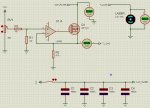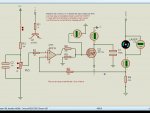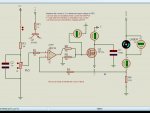Hey there, my first post into trying to show something productive!! 
Well, I've recently purchased a bar diode, it has about 60W peak power, don't worry, until my safety glasses arrive I will only blow up a few load resistors trying to build this "thing" aka PSU to power it. :drool:
The idea
The main concept idea is to use a PC PSU 3.3v rail our 5v rail, I'm a bit confused yet because I don't know how much the voltage will drop when I plug the bar/tec/water cooling to the supply and also don't know if the supply will handle it.. yet my 5V rail can go to about 40Amps...
Quick Circuit description:
Ok, now assuming that SMPS have "frequency issues", I was going for a capacitor bank on the beginning to avoid spikes and to do further filtering due to high amperage drain, wich without those the waveform would later ripple and of course, cause spikes that could damage my load (or the PSU itself).
The next stage should then be followed by a Variable Constant Current "external" controller, I would be controlling the current needed externally.
Depending on the diode temperature, we will assume that the current and resistance of the laser remains the same, therefore voltage will vary according to the diode's needs.
I would also need a way to monitor the output voltage of the supply to make sure it wouldn't exceed 2.2V, wich is the maximum operation rating of the Laser diode
Conception
Well, I've "quick-drawn" a circuit, and I've also been reading a lot about circuits using LM317 but I wanted to use an op-amp and a transistor (or transistors in paralell) since it seems to me to be more reliable and of course, cheap. Btw, I'm no electronics guru....
(this circuit was based on successive google searches and readouts).
Pleas check it out, any critics are welcome, I am willing to finish this and hopefully learn a bit more!!!
Regards to all!
Well, I've recently purchased a bar diode, it has about 60W peak power, don't worry, until my safety glasses arrive I will only blow up a few load resistors trying to build this "thing" aka PSU to power it. :drool:
The idea
The main concept idea is to use a PC PSU 3.3v rail our 5v rail, I'm a bit confused yet because I don't know how much the voltage will drop when I plug the bar/tec/water cooling to the supply and also don't know if the supply will handle it.. yet my 5V rail can go to about 40Amps...
Quick Circuit description:
Ok, now assuming that SMPS have "frequency issues", I was going for a capacitor bank on the beginning to avoid spikes and to do further filtering due to high amperage drain, wich without those the waveform would later ripple and of course, cause spikes that could damage my load (or the PSU itself).
The next stage should then be followed by a Variable Constant Current "external" controller, I would be controlling the current needed externally.
Depending on the diode temperature, we will assume that the current and resistance of the laser remains the same, therefore voltage will vary according to the diode's needs.
I would also need a way to monitor the output voltage of the supply to make sure it wouldn't exceed 2.2V, wich is the maximum operation rating of the Laser diode
Conception
Well, I've "quick-drawn" a circuit, and I've also been reading a lot about circuits using LM317 but I wanted to use an op-amp and a transistor (or transistors in paralell) since it seems to me to be more reliable and of course, cheap. Btw, I'm no electronics guru....
(this circuit was based on successive google searches and readouts).
Pleas check it out, any critics are welcome, I am willing to finish this and hopefully learn a bit more!!!
Regards to all!
Attachments
Last edited:









